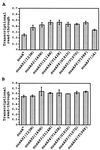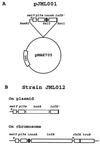Characterization of mutations in the metY-nusA-infB operon that suppress the slow growth of a DeltarimM mutant
- PMID: 11567010
- PMCID: PMC99689
- DOI: 10.1128/JB.183.20.6095-6106.2001
Characterization of mutations in the metY-nusA-infB operon that suppress the slow growth of a DeltarimM mutant
Abstract
The RimM protein in Escherichia coli is associated with free 30S ribosomal subunits but not with 70S ribosomes. A DeltarimM mutant shows a sevenfold-reduced growth rate and a reduced translational efficiency, probably as a result of aberrant assembly of the ribosomal 30S subunits. The slow growth and translational deficiency can be partially suppressed by increased synthesis of the ribosome binding factor RbfA. Here, we have identified 14 chromosomal suppressor mutations that increase the growth rate of a DeltarimM mutant by increasing the expression of rbfA. Nine of these mutations were in the nusA gene, which is located upstream from rbfA in the metY-nusA-infB operon; three mutations deleted the transcriptional terminator between infB and rbfA; one was an insertion of IS2 in infB, creating a new promoter for rbfA; and one was a duplication, placing a second copy of rbfA downstream from a promoter for the yhbM gene. Two of the nusA mutations were identical, while another mutation (nusA98) was identical to a previously isolated mutation, nusA11, shown to decrease termination of transcription. The different nusA mutations were found to increase the expression of rbfA by increasing the read-through of two internal transcriptional terminators located just downstream from the metY gene and that of the internal terminator preceding rbfA. Induced expression of the nusA(+) gene from a plasmid in a nusA(+) strain decreased the read-through of the two terminators just downstream from metY, demonstrating that one target for a previously proposed NusA-mediated feedback regulation of the metY-nusA-infB operon expression is these terminators. All of the nusA mutations produced temperature-sensitive phenotypes of rimM(+) strains. The nusA gene has previously been shown to be essential at 42 degrees C and below 32 degrees C. Here, we show that nusA is also essential at 37 degrees C.
Figures







References
-
- Bycroft M, Hubbard T J P, Proctor M, Freund S M V, Murzin A G. The solution structure of the S1 RNA binding domain: a member of an ancient nucleic acid-binding fold. Cell. 1997;88:235–242. - PubMed
Publication types
MeSH terms
Substances
LinkOut - more resources
Full Text Sources
Molecular Biology Databases

